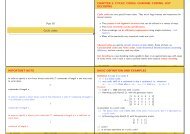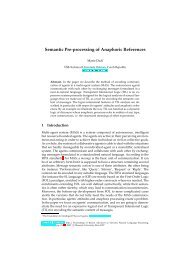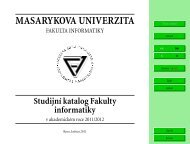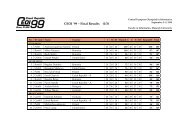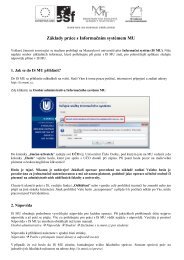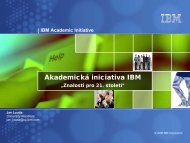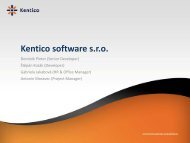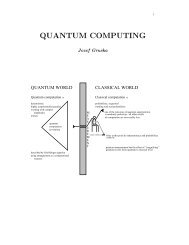Create successful ePaper yourself
Turn your PDF publications into a flip-book with our unique Google optimized e-Paper software.
<strong>Part</strong>-<strong>of</strong>-<strong>Speech</strong> <strong>Tagging</strong> <strong>for</strong> <strong>Old</strong> <strong>Chinese</strong><br />
Liang Huang 1 , Yi-Nan Peng 1 , and Huan Wang 2<br />
1 Department <strong>of</strong> Computer Science, Shanghai Jiaotong University<br />
No. 1954 Huashan Road, Shanghai<br />
P.R. China 200030<br />
2 Department <strong>of</strong> <strong>Chinese</strong> Literature and Linguistics, East China Normal University<br />
No. 3663 North Zhongshan Road, Shanghai,<br />
P.R. China 200062<br />
Abstract <strong>Old</strong> <strong>Chinese</strong> is essentially different from Modern <strong>Chinese</strong>, in both grammar and morphology. While there<br />
has recently been a great deal <strong>of</strong> work on part-<strong>of</strong>-speech (POS) tagging <strong>for</strong> modern <strong>Chinese</strong>, the POS <strong>of</strong> <strong>Old</strong> <strong>Chinese</strong> is<br />
largely neglected. To the best <strong>of</strong> our knowledge, this is the first work in this area. Fortunately however, in terms <strong>of</strong> tagging,<br />
<strong>Old</strong> <strong>Chinese</strong> is easier than modern <strong>Chinese</strong> in that most <strong>Old</strong> <strong>Chinese</strong> words are single-character-<strong>for</strong>med, requiring<br />
no segmentation. So in this paper, we will propose and analyze a simple statistical approach <strong>for</strong> POS tagging <strong>of</strong> <strong>Old</strong><br />
<strong>Chinese</strong>. We first designed a tagset <strong>for</strong> <strong>Old</strong> <strong>Chinese</strong> that is later shown to be accurate and efficient. Then we apply the<br />
hidden markov model (HMM) together with the Viterbi algorithm and made several improvements, such as sparse data<br />
problem handling, and unknown word guessing, both designed especially <strong>for</strong> <strong>Chinese</strong>. As the training set grows larger,<br />
the hit rate <strong>for</strong> bigram and trigram increases to 94.9% and 97.6%, respectively. The importance <strong>of</strong> our work lies in the<br />
previously unseen features that are special <strong>for</strong> <strong>Old</strong> <strong>Chinese</strong> and we have developed successful techniques to deal with<br />
them. Although <strong>Old</strong> <strong>Chinese</strong> is now a dead language, this work still has many applications in such areas as Ancient-<br />
Modern <strong>Chinese</strong> Machine Translation.<br />
Key Words. <strong>Part</strong>-<strong>of</strong>-speech tagging, <strong>Old</strong> <strong>Chinese</strong>, hidden markov model, Viterbi algorithm, bigram, trigram, statistical<br />
approach<br />
1 Introduction<br />
<strong>Part</strong>-<strong>of</strong>-speech tagging is fundamental in natural language processing. It selects the most likely sequence <strong>of</strong> syntactic categories<br />
(part-<strong>of</strong>-speech) <strong>for</strong> the words in a sentence, and passes its output to the next processing level, usually a syntactic<br />
parser. Over the last twenty years, the correctness <strong>of</strong> POS tagging has increased dramatically on some famous English<br />
corpora like the Penn Treebank Project [4]. And the POS tagging <strong>for</strong> <strong>Chinese</strong> has also resulted in very high hit rates [8].<br />
There are many machine learning approaches <strong>for</strong> automated POS tagging, and the most successful <strong>of</strong> them are rule-based<br />
methods and statistical methods. So in this section, we will first briefly summarize the different approaches <strong>of</strong> POS tagging,<br />
then point out the particularities <strong>of</strong> <strong>Chinese</strong> and <strong>Old</strong> <strong>Chinese</strong> POS, and finally gives the organization <strong>of</strong> the rest <strong>of</strong><br />
the paper.<br />
1.1 Rule-Based Approach<br />
Typical rule based approaches [9] use contextual in<strong>for</strong>mation to assign tags to ambiguous words. Generally rule-based<br />
taggers have error rates substantially higher than the state-<strong>of</strong>-the-art statistical taggers. In [4], a highly competitive tagger<br />
is described which captures the learned knowledge in a set <strong>of</strong> simple deterministic rules instead <strong>of</strong> a large table <strong>of</strong> statistics.<br />
And in [5], a trans<strong>for</strong>mation-based error-driven tagger was developed with contextual rules as patches, which greatly<br />
increases the hit rates.<br />
1.2 Statistical Approach<br />
Stochastic taggers [2, 3, 6, 8, 10] have obtained a high degree <strong>of</strong> accuracy without per<strong>for</strong>ming any syntactic analysis <strong>of</strong> the<br />
input. There are many methods inside the statistical model, among them are the famous hidden markov model [2, 3, 8, 10]<br />
and the maximum entropy approach [6].<br />
The hidden markov model is the most widely used model <strong>for</strong> POS tagging. It originates from the Viterbi algorithm [1].<br />
In this model, word-tag probabilities and n-gram probabilities (parameters in the hidden markov model) are obtained from<br />
the training set, usually a manually annotated corpus.<br />
1
The maximum entropy approach <strong>of</strong>fers a better use <strong>of</strong> contextual in<strong>for</strong>mation. The experiment on Penn Treebank Wall<br />
St. Journal shows that this method gives a high hit rate than previous HMM models [6].<br />
1.3 The Limitations and Improvements <strong>of</strong> HMM<br />
The main limitations <strong>of</strong> HMM are sparse data problem (especially <strong>for</strong> trigram) and unknown word guessing. A number <strong>of</strong><br />
methods have been developed to solve these two problems [10, 13, 4, 5].<br />
Sparse Data Problem. We have to move from bigrams to tri-grams, 4-grams and more to include more tags into the<br />
consideration. Then the problem <strong>of</strong> the sparse data set or inadequate parameters emerges [8]. In [10], a smoothing method<br />
is developed to solve it using interpolations <strong>of</strong> uni-, bi- and tri-grams. But this approach requires too much computation at<br />
the training phase.<br />
Unknown Word Handling. Previous works show that the hit rates <strong>for</strong> unknown words are substantially lower than those<br />
known words [13, 10]. In [4] and [5], guessing from suffixes is proposed, but it is not applicable to <strong>Chinese</strong>. And in [13],<br />
a supporting vector approach is presented, yet still too time-consuming.<br />
So in this paper, we will present simple-yet-effective methods to handle these 2 problems.<br />
1.4 POS <strong>Tagging</strong> <strong>of</strong> <strong>Chinese</strong> and <strong>Old</strong> <strong>Chinese</strong><br />
Most <strong>of</strong> the taggers were designed <strong>for</strong> English, with a little <strong>for</strong> other European languages. <strong>Chinese</strong>, however, is totally<br />
different from the Indo-European languages in its special grammar. And some features discussed above cannot be transplanted<br />
to the tagging <strong>of</strong> <strong>Chinese</strong> directly.<br />
Word Segmentation. Modern <strong>Chinese</strong> is written without spaces to separate between words. For example, consider the<br />
following phrase<br />
江 泽 民 主 席<br />
jiang ze min zhu xi<br />
can be segmented as<br />
江泽民 / 主席<br />
jiang ze min / zhu xi<br />
(in English, President Jiang Ze-Ming)<br />
and can be also segmented in a different way<br />
江泽 / 民主 / 席<br />
jiang ze / min zhu / xi<br />
(In English, rivers and ponds / democracy / seat)<br />
Apparently, the second segmentation is nonsense. So successful segmentation is the first step <strong>of</strong> POS tagging [8],<br />
which made tagging <strong>for</strong> <strong>Chinese</strong> much more difficult than taggers <strong>for</strong> European languages.<br />
Generally speaking, <strong>Old</strong> <strong>Chinese</strong> is even more difficult than modern <strong>Chinese</strong>, in its obsolete grammar patterns. But actually,<br />
from the tagger’s point <strong>of</strong> view, <strong>Old</strong> <strong>Chinese</strong> is somewhat easier, because most words are written in the singlecharacter<br />
<strong>for</strong>m, thus requiring no need <strong>of</strong> word segmentation.<br />
Punctuation. Un<strong>for</strong>tunately, <strong>Old</strong> <strong>Chinese</strong> is written without any punctuations, and all the inputs to our program are<br />
manually punctuated. This is another specialty <strong>of</strong> <strong>Chinese</strong> processing. Fortunately most <strong>Old</strong> <strong>Chinese</strong> documents have<br />
already been manually punctuated in the 20 th century, so our work is still right-to-use <strong>for</strong> applications.<br />
Unknown word guessing. Another area where methods <strong>for</strong> European languages are not applicable to <strong>Chinese</strong> Processing.<br />
In most publications <strong>for</strong> tagging European languages, a common approach using suffixes or surrounding context <strong>of</strong><br />
unknown words is used [10, 5]. But neither suffixes nor capitalization is extant in <strong>Chinese</strong>. Especially in <strong>Old</strong> <strong>Chinese</strong>, a<br />
character is a word, so no separation <strong>of</strong> word is possible. Because in computer, <strong>Chinese</strong> is presented by GB/BIG5 code<br />
and we cannot get any in<strong>for</strong>mation <strong>of</strong> meaning or structure from the code. So we will present our own approach <strong>for</strong><br />
handling unknown words.<br />
2
<strong>Old</strong><br />
<strong>Chinese</strong><br />
Modern<br />
<strong>Chinese</strong><br />
Fig. 1. The complete processing procedure <strong>of</strong> Modern/<strong>Old</strong> <strong>Chinese</strong> by comparison to the Indo-European Languages<br />
The rest <strong>of</strong> the paper is organized as follows. In section 2, we give a summary <strong>of</strong> lexical analysis <strong>of</strong> <strong>Old</strong> <strong>Chinese</strong> and<br />
discuss the design the tagset. The dynamic-programming-based tagging algorithm and features are presented in Section 3.<br />
Algorithm per<strong>for</strong>mance is evaluated in Section 4. In Section 5, we give a conclusion <strong>of</strong> the paper and briefly explore the<br />
applications and future work.<br />
2 <strong>Old</strong> <strong>Chinese</strong> Corpus and Tagset<br />
The design <strong>of</strong> tagset is very crucial to the accuracy and efficiency <strong>of</strong> the tagging algorithm, and this was largely neglected<br />
in the literature where almost all the researchers use those famous corpora and their tagset as the standard test-beds. In<br />
addition, the ambiguity <strong>of</strong> <strong>Old</strong> <strong>Chinese</strong> is substantially higher than Indo-European languages. So in this section, we will<br />
focus on the construction <strong>of</strong> corpus and design <strong>of</strong> the tagset.<br />
2.1 The Corpus<br />
The only established corpus <strong>of</strong> <strong>Old</strong> <strong>Chinese</strong> is the Taiwan-Corpus [12]. But <strong>for</strong> the purpose <strong>of</strong> evaluating our own tagging<br />
algorithm and tagset, we constructed a small-sized corpus from the classical <strong>Old</strong> <strong>Chinese</strong> documents like 论语 (lun yu,<br />
by the students <strong>of</strong> Confucius) and 道德经 (dao de jin, by Laozi, the father <strong>of</strong> Daoism) and some other classics.<br />
Our selection criteria <strong>of</strong> texts is: omit those with proper nouns, omit those with very hard words, and omit grammatical<br />
exceptions. As these three assumptions actually holds <strong>for</strong> most <strong>Old</strong> <strong>Chinese</strong> Documents, our corpus does reflect typical<br />
<strong>Old</strong> <strong>Chinese</strong>. And finally we got a corpus <strong>of</strong> about 1000 words as the training set. For the test set, the three criteria still<br />
holds. And we selected a relatively simple text from 荀子 (by Xunzi, another great figure <strong>of</strong> Confucianism). The length<br />
<strong>of</strong> the test set is about 200 words.<br />
2.2 Tagset<br />
Indo-European<br />
Languages<br />
There is a trade<strong>of</strong>f in the design <strong>of</strong> the tagset. The sizes <strong>of</strong> tagsets in previous works vary from smaller than 20 to larger<br />
than 400. On one hand, in order to obtain a high accuracy <strong>of</strong> automatic tagging, we divide the basic lexical categories like<br />
verb and adjective into sub-categories, like adjective used as attributive or as predicate. Obviously these discriminations<br />
are crucial, but it does severe the sparse data set problem. Considering the small corpus in this work, we did not use such<br />
accurate tagsets as in [8].<br />
As <strong>Chinese</strong> grammar focus on the sequence <strong>of</strong> words rather than the morphological in<strong>for</strong>mation, it is much more ambiguous<br />
than languages with inflexions like Indo-European languages. In other words, contextual in<strong>for</strong>mation contributes<br />
more to the part-<strong>of</strong>-speech tagging than lexical in<strong>for</strong>mation. Taking this into account, we designed a tagset with special<br />
interest not only to the lexical categories, but also the categories <strong>of</strong> components a word may belong. For example, we<br />
discriminate adjectives into 4 subcategories like Adjective as attributive, etc. (See table 1). This discrimination turns out to<br />
be an important contributing factor <strong>of</strong> the tagging accuracy. (See Section 4).<br />
Note that we map punctuations into 2 sets: period and comma.<br />
Table 1. Tagset <strong>for</strong> <strong>Old</strong> <strong>Chinese</strong><br />
Punctuator<br />
Segmenter<br />
POS Tagger<br />
No. Tag Name Meaning English meaning<br />
0 N 名词 Noun<br />
1 Aa 形容词作定语 Adjective as attributive<br />
2 Aw 形容词作谓语 Adjective as verbal phrase<br />
3 Az 形容词作状语 Adjective as adverbial<br />
4 Ab 形容词作表语 Adjective as predicate<br />
3<br />
Syntactic Parser Semantic<br />
Interpreter
5 Ad 副词 Adverb<br />
6 Vi 不跟宾语的动词 Verb without object<br />
7 Vt 跟宾语的动词 Verb with object<br />
8 Vy 意动 Special <strong>for</strong> <strong>Old</strong> <strong>Chinese</strong><br />
9 Vs 使动 Special <strong>for</strong> <strong>Old</strong> <strong>Chinese</strong><br />
10 Vb 省略宾语的动词 Verb with object omitted<br />
11 Vx 系动词 Predicate verb<br />
12 Vyou 动词“有” The Verb have<br />
13 Vyue 动词“曰” The Verb say<br />
14 Conj 连词 Conjunction<br />
15 Yq 语气词 Exclamation<br />
16 Prep 带宾语的介词 Preposition with object<br />
17 Prepb 省略宾语的介词 Preposition with object omitted<br />
18 Num 数词 Number<br />
19 Qpron 疑问代词 Wh-pronoun<br />
20 Npron 名词性代词 Noun-pronoun<br />
21 Apron 形容词性代词 Adjective-pronoun<br />
22 Za<br />
“之”作定语后置<br />
Special <strong>for</strong> <strong>Old</strong> <strong>Chinese</strong><br />
23 Zj<br />
标志<br />
“者”作名词性词尾 Special <strong>for</strong> <strong>Old</strong> <strong>Chinese</strong><br />
24 Zd “之”作“的” Special <strong>for</strong> <strong>Old</strong> <strong>Chinese</strong><br />
25 Zw “之”作取消主谓 Special <strong>for</strong> <strong>Old</strong> <strong>Chinese</strong><br />
26 Fy<br />
独立性标志<br />
发语词 Special <strong>for</strong> <strong>Old</strong> <strong>Chinese</strong><br />
27 Period 终止性标点 。;?!<br />
28 Comma 停顿性标点 ,、:<br />
3 <strong>Tagging</strong> Algorithms and Features<br />
Our tagging algorithm is based on the Hidden Markov Model and has several improvements.<br />
Let w1, …wT be a sequence <strong>of</strong> words. We want to find the sequence <strong>of</strong> POS tags t1, …tT that maximizes the probability<br />
Pr( 1 T 1 T<br />
t ,..., t | w ,..., w )<br />
(1)<br />
and according to Bayes’ rule [11], it equals<br />
t ,..., t ) ⋅ Pr( w ,..., w | t ,..., t )) / Pr( w ,..., w )<br />
(2)<br />
(Pr( 1 T<br />
1 T 1 T<br />
1 T<br />
as the denominator is pre-determined, we only need to find the sequence t1, …tT that maximizes the <strong>for</strong>mula<br />
Pr( 1 T 1 T 1 T<br />
t ,..., t ) ⋅ Pr( w ,..., w | t ,..., t )<br />
(3)<br />
Obviously, the above <strong>for</strong>mula requires far too much data to calculate accurately. So we use the n-gram hidden markov<br />
models.<br />
3.1 Hidden Markov Model<br />
As stated be<strong>for</strong>e, POS taggers seldom use n-grams <strong>for</strong> n>3, due to the sparse data problem. So in this paper, we use unigrams,<br />
bi-grams and tri-grams.<br />
Different from traditional HMM, we denote lexical frequencies to be word-tag probabilities, not tag-word probabilities.<br />
Though in this way it doesn’t con<strong>for</strong>m to the Bayes’ rule, it is even more effective in POS tagging <strong>of</strong> <strong>Chinese</strong>, as stated in<br />
[8], and we also found it much easier when handling unknown words.<br />
We denote unigrams, bigrams, and trigrams probabilities as follows,<br />
4
Unigrams<br />
f ( t)<br />
Pr( t)<br />
=<br />
N<br />
f ( t1,<br />
t2<br />
)<br />
Bigrams Pr( t1<br />
| t2<br />
) =<br />
f ( t )<br />
f ( t1,<br />
t2<br />
, t3)<br />
Trigrams Pr( t1<br />
| t2<br />
, t3<br />
) =<br />
f ( t , t )<br />
f ( t,<br />
w)<br />
Lexical Pr( t | w)<br />
=<br />
f ( w)<br />
<strong>for</strong> all t1, t2, t3 in the tagset and w in the lexicon. N is the total number <strong>of</strong> tokens in the training set.<br />
Now <strong>for</strong> bigram model, we need to maximize the following:<br />
P = Π t | t − ) ⋅Pr(<br />
t | w )<br />
(8)<br />
Pr( i i 1 i i<br />
For trigram model, we need to maximize the following:<br />
P = Π Pr( ti<br />
| ti−<br />
2, ti−1)<br />
⋅ Pr( ti<br />
| wi<br />
)<br />
(9)<br />
3.2 Dynamic Programming Algorithm<br />
2<br />
2<br />
3<br />
Our tagging algorithm is based on the Viterbi Algorithm [1,11], which is Dynamic Programming in nature.<br />
For the simplicity <strong>of</strong> programming and accuracy <strong>of</strong> tagging, we intentionally add a period tag be<strong>for</strong>e each sentence and<br />
assume that each sentence ends with a period. This method is better than the traditional loose end in other publications<br />
[10].<br />
Bigram model<br />
For bigram model, the dynamic programming algorithm is as follows (in pseudo-code)<br />
list[0]="period";<br />
<strong>for</strong> i=1 to len<br />
<strong>for</strong> j=0 to tagnum-1<br />
best[i][j]=MAX k=0~tagnum-1 (<br />
best[i-1][k]*prob[list[i]]*markov[k][j])<br />
pre[i][j]=index <strong>of</strong> k that gave the max above<br />
Trigram model<br />
For trigram model, the algorithm needs some considerations. For the first word, as it is just after the first intentional period,<br />
it has fewer than 2 precedings; and <strong>for</strong> words just after any punctuation in the sentence, the same problem also occurs.<br />
So here we use bigrams results <strong>for</strong> these occasions. The trigram algorithm is as follows<br />
list[0]="period";<br />
<strong>for</strong> i=1 to len<br />
if list[i-1] is a punctuation then<br />
else<br />
use bigrams results instead<br />
5<br />
(4)<br />
(5)<br />
(6)<br />
(7)
<strong>for</strong> j=0 to tagnum-1<br />
<strong>for</strong> l=0 to tagnum-1<br />
best3[i][l][j]=MAX k=0~tagnum-1 (<br />
best3[i-1][k][l] *markov3[k][l][j]<br />
*prob[list[I]][j])<br />
pre3[i][l][j]=index <strong>of</strong> k that gave the max above<br />
3.3 Unknown Word Handling<br />
Recall that most methods used in unknown words guessing <strong>for</strong> European languages are not applicable to <strong>Chinese</strong> or<br />
<strong>Old</strong> <strong>Chinese</strong>. So in this paper we present a simple but novel approach.<br />
For any word that does not occur in the training set, we denote its word-tag probabilities to be the unigrams probabilities<br />
<strong>for</strong> each tag. For example, <strong>for</strong> an unknown word w, we have<br />
f ( ti<br />
)<br />
Pr( ti<br />
| w)<br />
= unigram(<br />
ti<br />
) =<br />
N<br />
N is the total number <strong>of</strong> words in the training set.<br />
Though it violates the classical probability theory, experiments (see Section 4) indicate it quite effective, especially <strong>for</strong><br />
trigram model. The underlying reason <strong>for</strong> its success is the independence <strong>of</strong> phases in Dynamic Programming.<br />
3.4 Sparse Data Problem<br />
Besides the unknown word handling, the problem <strong>of</strong> sparse data set is also difficult to handle. As stated be<strong>for</strong>e, the size<br />
<strong>of</strong> our corpus is very small, compared to well-established English corpora. So we need a technique to unknown sequences,<br />
i.e. unknown bigram pairs or trigram sequences. Rather than the complicated smoothing method in [10], we here present a<br />
simpler approach made <strong>of</strong> 2 steps:<br />
1. Add a very small number, usually 10 -60 , to all lexical probabilities. Obviously it will not affect the correct probabilities<br />
learned from the corpus. But by this addition, we enable the algorithm <strong>for</strong> guessing the most probable<br />
context sequence, when word-tag pairs sequence is not presented in the corpus. This is effective especially when<br />
context in<strong>for</strong>mation is quite deterministic (provides enough hints) at certain positions.<br />
2. In the dynamic programming, if still no possible sequence at certain position, use the lower-level n-gram, i.e., <strong>for</strong><br />
bigram model, use lexical probabilities, and <strong>for</strong> trigram, use big ram’s results. It is an expedient approach, yet still<br />
works quite well as experiments indicated.<br />
4 Per<strong>for</strong>mance Evaluations<br />
4.1 Accuracy<br />
We made the learning set enlarging slowly and test the per<strong>for</strong>mance (learning curves) <strong>of</strong> the tagset and the algorithm. As<br />
the training set grows larger, the result is show in the following figures. We not only test the overall hit rates, but also the<br />
known and unknown hit rates separately.<br />
6<br />
(10)
Fig. 2. Learning Curves <strong>for</strong> the overall hit rate: bigram model vs. trigrams model. The learning length increases from 686 to 1000 tokens.<br />
Figure 2 shows the learning curves <strong>of</strong> the taggers, i.e., the accuracy depending on the amount <strong>of</strong> training data. Corpus<br />
size is the training length, namely, the number <strong>of</strong> tokens used <strong>for</strong> training. As corpus expanding, the hit rate <strong>of</strong> bigrams<br />
and trigrams increases from 73.9% to 94.9% and from 69.5% to 97.6%, respectively. At the beginning, when corpus is<br />
small, trigram hit rates are lower than bigram hit rate mainly because <strong>of</strong> the sparse data problem. And at the end, when<br />
contextual in<strong>for</strong>mation is more abundant, trigrams overrun bigrams substantially.<br />
(a) (b)<br />
Fig. 3. Learning Curves <strong>of</strong> known words and unknown words. (a) Bigram model. (b) Trigram model. The percentage <strong>of</strong> unknown<br />
words decreases from 39.4% at the beginning to 8% at the end, almost linearly.<br />
Figure 3 shows the learning curves <strong>of</strong> known words and unknown words. Different from most POS tagging works<br />
found in the literature where the accuracies <strong>for</strong> known words are very high even <strong>for</strong> very small corpora [11, 10], our work<br />
shows that <strong>for</strong> tagging <strong>of</strong> <strong>Old</strong> <strong>Chinese</strong>, the beginning accuracy <strong>for</strong> known words is rather low. In [10], the author concludes<br />
that even considering the lexical frequencies only, the hit rate would be about 90 percent, primarily because over<br />
half <strong>of</strong> the words appearing in most corpora are not ambiguous. But <strong>for</strong> <strong>Old</strong> <strong>Chinese</strong>, a language full <strong>of</strong> lexical ambiguity,<br />
with an accurate tagset used, the situation is entirely different. Figure 3 shows the beginning accuracy <strong>for</strong> known words<br />
are only 79.7% and 74.9% <strong>for</strong> bigrams and trigrams, respectively.<br />
Unknown word guessing is another successful part <strong>of</strong> our work. Figure 3 shows our guessing technique very effective.<br />
The beginning hit rates <strong>for</strong> bigrams and trigrams are 65.0% and 60.9%, respectively, about the same with most successful<br />
works in the literature [6, 10, 13]. But the learning curve <strong>for</strong> unknown words rises rapidly and at the end, the hit rate are<br />
85.1% and 93.2%, a little higher than those previous works. The high hit rate <strong>of</strong> unknown words guessing <strong>of</strong> trigram<br />
model shows that our technique is especially effective when contextual in<strong>for</strong>mation (hint) is quite deterministic at certain<br />
position.<br />
4.2 Error Analysis<br />
Though the overall hit rates are high, there are still many errors made by the taggers. Obviously, bigrams made much more<br />
errors than trigrams, when corpus is relatively large. The typical errors made by bigrams are those grammatical structures<br />
special in <strong>Old</strong> <strong>Chinese</strong> that must be recognized from at least 3 words, regardless <strong>of</strong> the training length. The following is a<br />
list <strong>of</strong> bigram errors.<br />
1. the pre-positioned object structure, a special structure called 宾语前置 (bin yu qian zhi) in <strong>Old</strong> <strong>Chinese</strong>.<br />
7
igram<br />
古 n 之 zd 人 n 不 ad 余 npron 欺 vi。<br />
correct 古 n 之 zd 人 n 不 ad 余 npron 欺 vt 。<br />
2. prepositional phrase as adverbial: bigram 不 ad 为 vt 尧 n 存 vi ,<br />
correct 不 ad 为 prep 尧 n 存 vi ,<br />
3. Vt+n or ad+vi: bigram 人 n 而 conj 无 ad 信 vi ,<br />
correct 人 n 而 conj 无 vt 信 n ,<br />
The above errors have all been corrected in trigram model. And there are very few trigram errors. Typical errors are those<br />
with unknown words.<br />
5 Conclusion and Future Work<br />
In this paper we have proposed and analyzed a simple corpus-based statistical method <strong>of</strong> part-<strong>of</strong>-speech tagging <strong>for</strong> <strong>Old</strong><br />
<strong>Chinese</strong> texts. To the best <strong>of</strong> our knowledge, this is the first work in the area <strong>of</strong> POS tagging <strong>of</strong> <strong>Old</strong> <strong>Chinese</strong>.<br />
A special tagset is first designed <strong>for</strong> <strong>Old</strong> <strong>Chinese</strong>. We then base our work on the hidden markov model (HMM) model<br />
and the Viterbi algorithm. In addition, several features, such as sparse data problem handling are presented and we also<br />
developed an unknown word guessing schema especially <strong>for</strong> <strong>Chinese</strong>. We constructed a small-size corpus <strong>of</strong> <strong>Old</strong> <strong>Chinese</strong><br />
classics and selected a typical and simple text as the test set. As the training set grows larger, the hit rate increases to<br />
94.9% <strong>for</strong> bi-gram and 97.6% <strong>for</strong> tri-gram. The most important innovation <strong>of</strong> our work is that we have presented many<br />
previously unseen features that are special <strong>for</strong> <strong>Old</strong> <strong>Chinese</strong> and we have developed successful techniques to deal with<br />
them.<br />
For applications, although <strong>Old</strong> <strong>Chinese</strong> is now a dead language, our work is still useful in mainly two areas: Ancient-<br />
Modern <strong>Chinese</strong> Machine Translation and In<strong>for</strong>mation Retrieval <strong>of</strong> <strong>Old</strong> <strong>Chinese</strong>. <strong>Old</strong> <strong>Chinese</strong> is known to be most abundant<br />
source <strong>of</strong> in<strong>for</strong>mation <strong>for</strong> ancient and medieval civilization, when China is the leading country <strong>of</strong> the world. And the<br />
percentage <strong>of</strong> <strong>Old</strong> <strong>Chinese</strong> documents that have been translated to modern <strong>Chinese</strong> is very low. So the above two areas<br />
have a very bright future.<br />
For future work, as stated be<strong>for</strong>e, the computational study <strong>of</strong> <strong>Old</strong> <strong>Chinese</strong> is just commencing. And our future work includes<br />
a syntactic chart-based bottom-up parser, <strong>for</strong> a probabilistic context-free grammar (PCFG) <strong>of</strong> <strong>Old</strong> <strong>Chinese</strong>. With<br />
the <strong>for</strong>ward-backward algorithm which provides context-dependent in<strong>for</strong>mation, the chart-based parser can be statistically<br />
accurate.<br />
Another possible work is the sentence-punctuator. We think by a few changes in the HMM model will yield an effective<br />
punctuator.<br />
Last but most important, we need larger corpora. The corpus used in our program is too small, and there are very few<br />
annotated <strong>Old</strong> <strong>Chinese</strong> corpora. So we may first construct a manually annotated medium-sized corpora <strong>for</strong> future study.<br />
References<br />
1. Viterbi, A.: Error bounds <strong>for</strong> convolution codes and an asymptotically optimal decoding algorithm. IEEE Trans. on In<strong>for</strong>mation<br />
Theory 13:260-269. 1967<br />
2. Leech, G. et al.: The Automatic Grammatical <strong>Tagging</strong> <strong>of</strong> the LOB Corpus, ICAME News, 7 (1983), 13-33.<br />
3. Merialdo, B.: <strong>Tagging</strong> Text with a Probabilistic Model, IEEE International Conference on Acoustics, <strong>Speech</strong> and Signal Processing<br />
(ICASSP), 1991. 809-812.<br />
4. Brill, E.: A simple rule-based part-<strong>of</strong>-speech tagger, Proceeding <strong>of</strong> the 3rd Conference on Applied Natural Language Processing(ACL),<br />
1992, pp 152-155.<br />
5. Brill, E.: Trans<strong>for</strong>mation-Based Error-Driven Learning and Natural Language Processing: A Case Study in <strong>Part</strong>-<strong>of</strong>-<strong>Speech</strong> <strong>Tagging</strong>.<br />
Computational Linguistics, 21(4), 1995 pages 543–565.<br />
6. Ratnaparkhi,A. et al.: A Maximum Entropy Model <strong>for</strong> <strong>Part</strong>-<strong>of</strong>-<strong>Speech</strong> <strong>Tagging</strong>. In Proceedings <strong>of</strong> Conference on Empirical Methods<br />
in Natural Language Processing(EMNLP-1), 1996, pages 133–142<br />
7. Charniak, E. et al. : Equations <strong>for</strong> <strong>Part</strong>-<strong>of</strong>-<strong>Speech</strong> <strong>Tagging</strong>. In Proceedings <strong>of</strong> the Eleventh National Conference on Artificial Intelligence(AAAI-93),<br />
1993. pages 784–789.<br />
8. Lua, K.: <strong>Part</strong> <strong>of</strong> <strong>Speech</strong> <strong>Tagging</strong> <strong>of</strong> <strong>Chinese</strong> Sentences Using Genetic Algorithm, Proceedings <strong>of</strong> Conference on <strong>Chinese</strong> Computing,<br />
Singapore, Jun. 1996, pp. 45-49<br />
9. Hindle, D. Acquiring disambiguation rules from text. In Proceedings <strong>of</strong> 27 th Annual Meeting <strong>of</strong> the Association <strong>for</strong> Computational<br />
Linguistics, 1989<br />
10. Brant, T.: TnT — A Statistical <strong>Part</strong>-<strong>of</strong>-<strong>Speech</strong> Tagger. In Proceedings <strong>of</strong> the 6th Applied NLP Conference(ANLP-2000), 2000,<br />
pages 224–231.<br />
11. Allen, J.: Natural Language Understanding, The Benjamin/Cummings Publishing Company, Inc. 1995<br />
12. Wei, P. et al. : Historical Corpora <strong>for</strong> Synchronic and Diachronic Linguistics Studies, Pacific Neighborhood Consortium, 1997<br />
13. Nakagawa, T. et al. : Unknown Word Guessing and <strong>Part</strong>-<strong>of</strong>-<strong>Speech</strong> <strong>Tagging</strong> Using Support Vector Machines, Proceedings <strong>of</strong> the<br />
6 th Natural Language Processing Pacific Rim Symposium, 2001<br />
8



